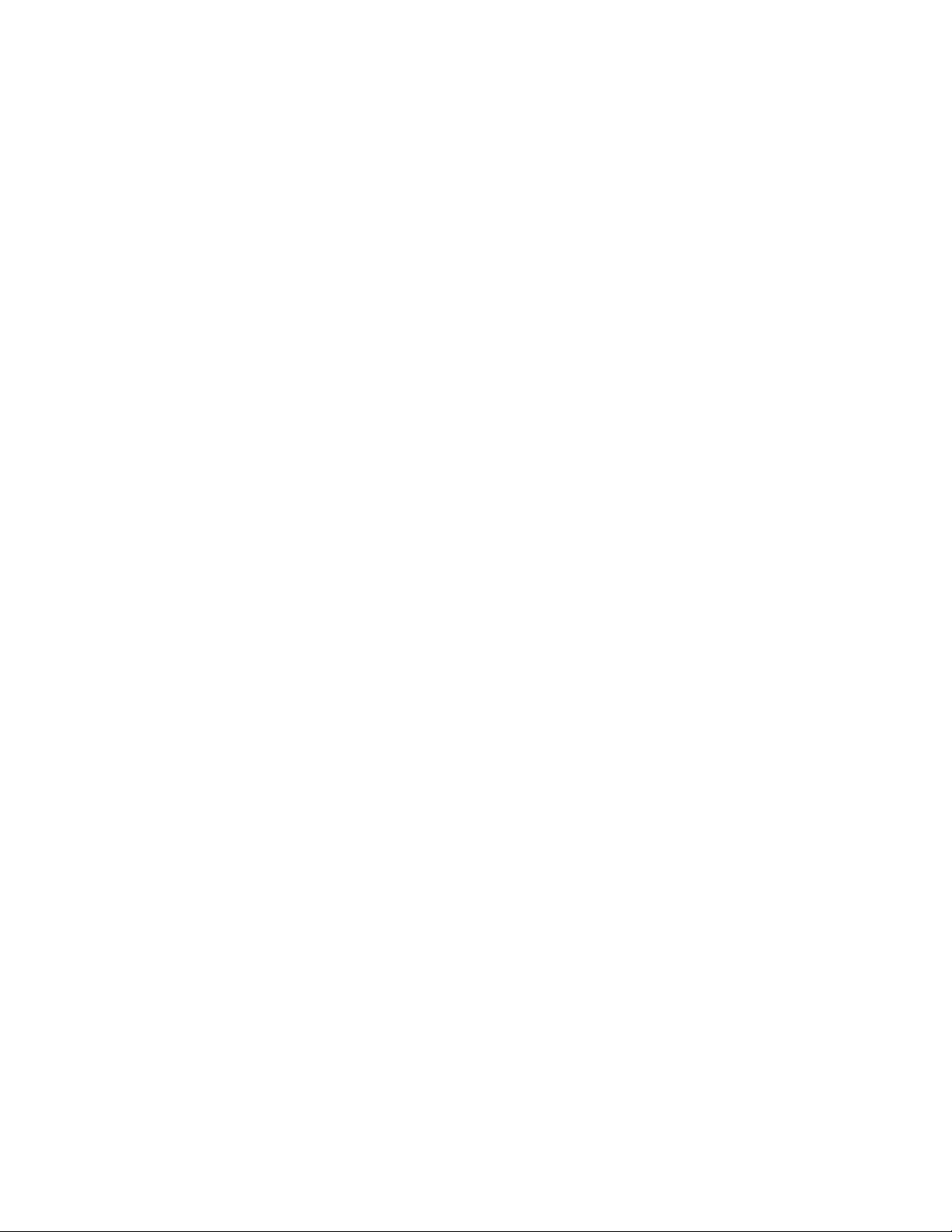
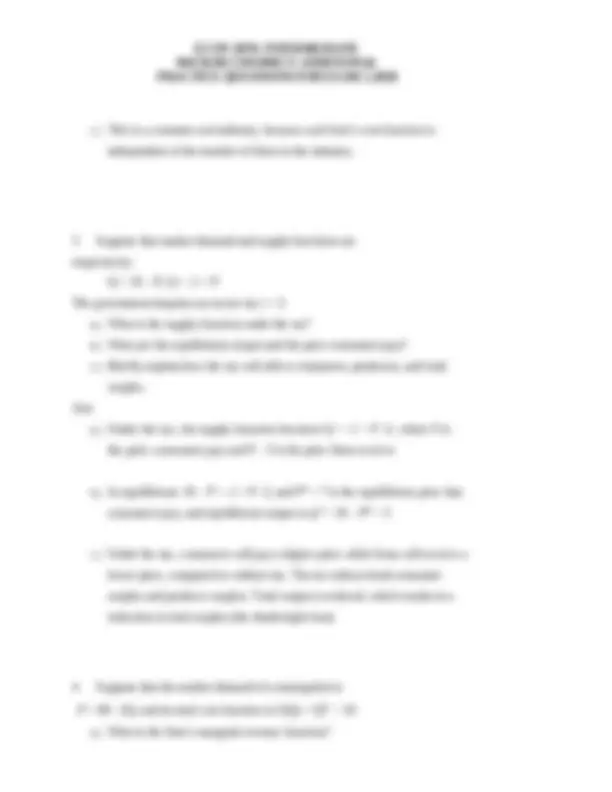
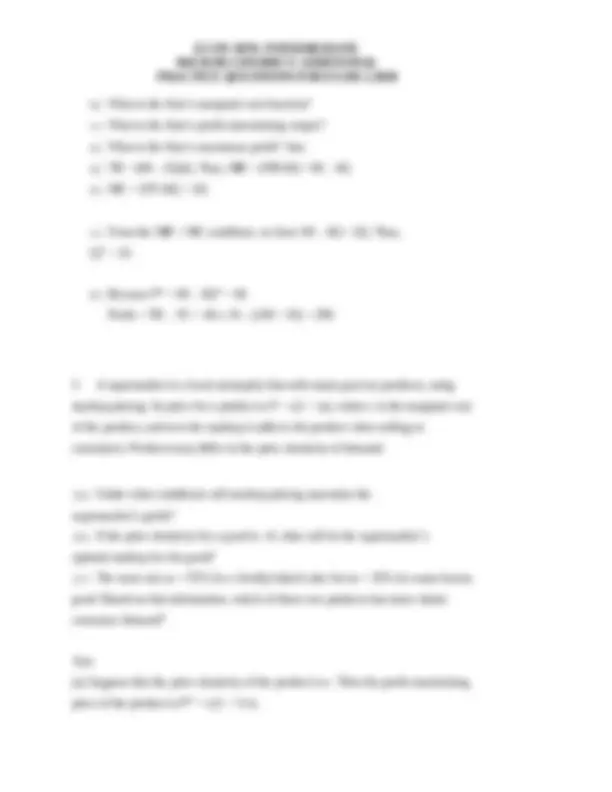
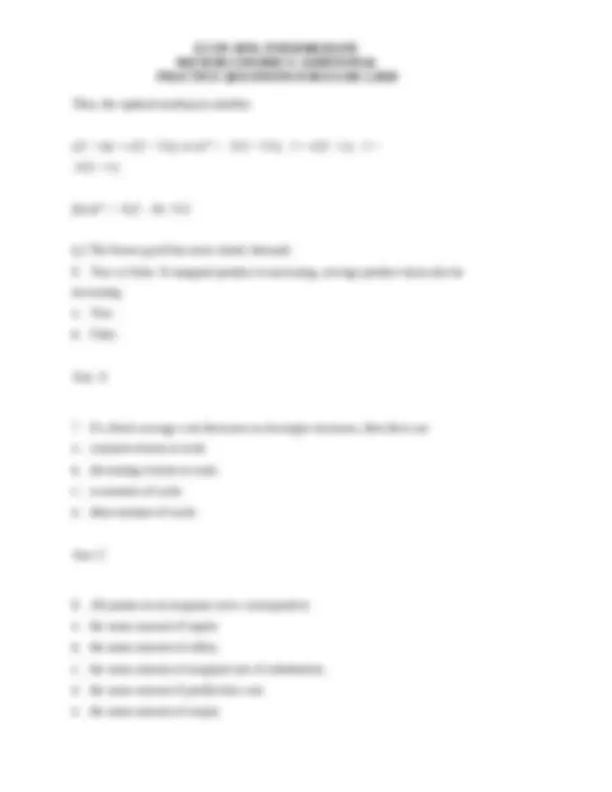
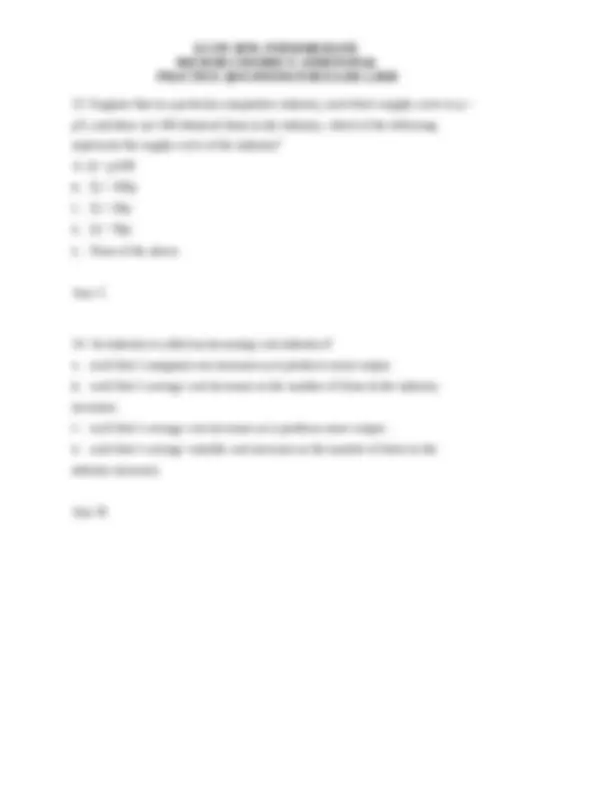
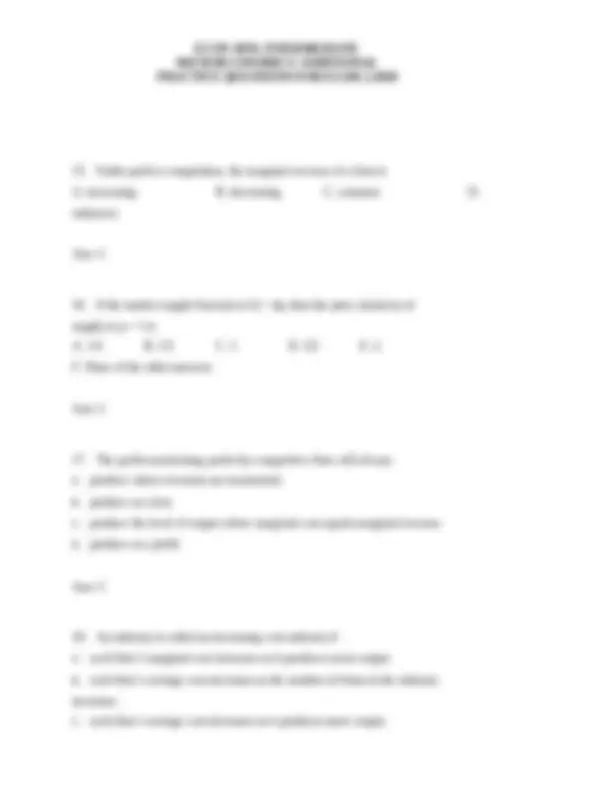
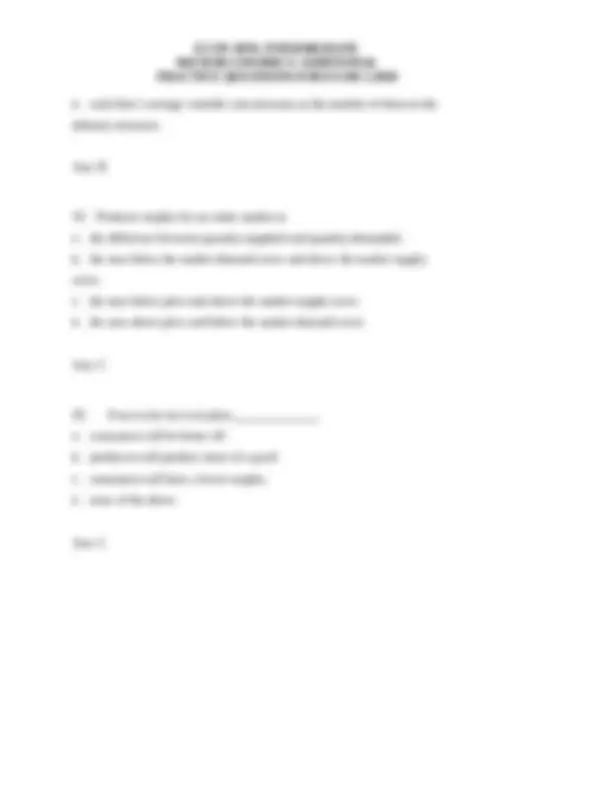
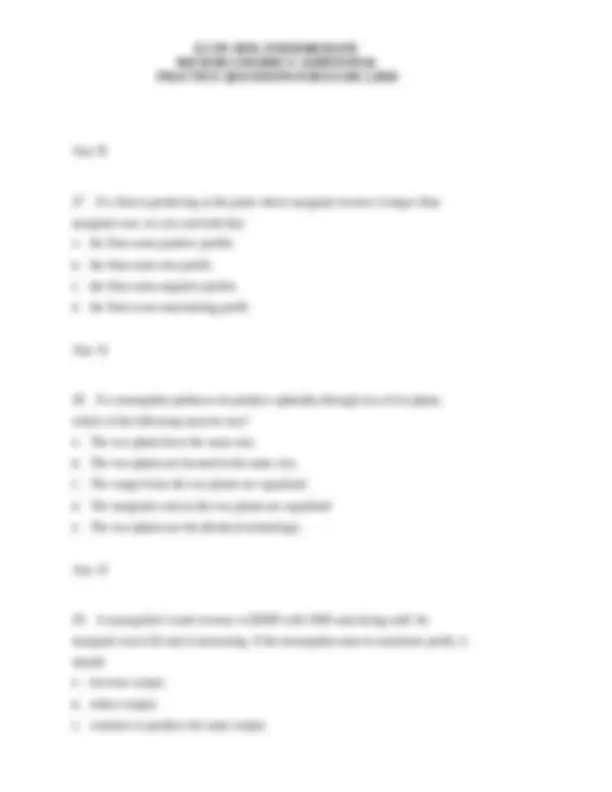
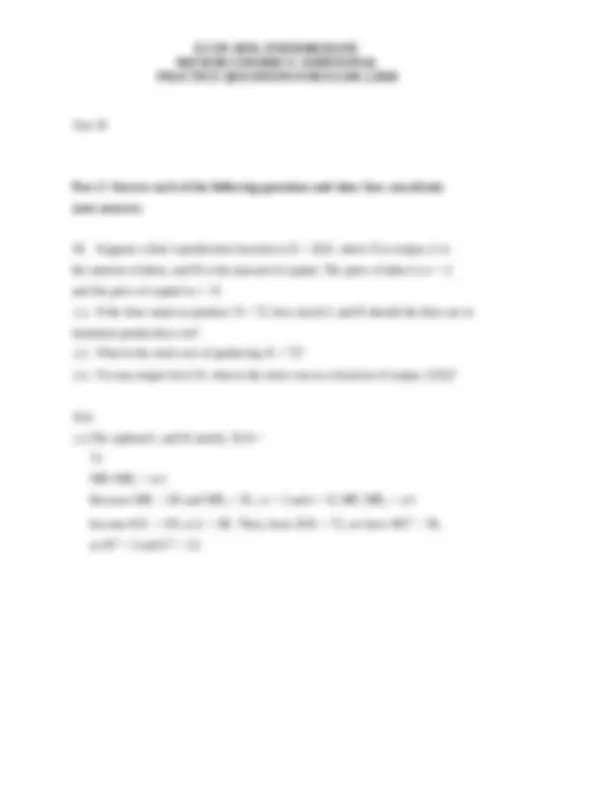
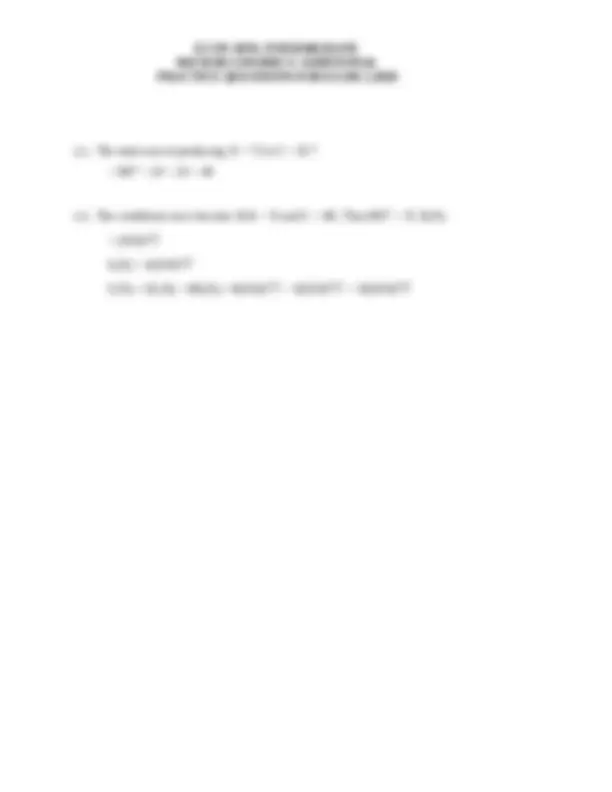


Study with the several resources on Docsity

Earn points by helping other students or get them with a premium plan


Prepare for your exams
Study with the several resources on Docsity

Earn points to download
Earn points by helping other students or get them with a premium plan
Community
Ask the community for help and clear up your study doubts
Discover the best universities in your country according to Docsity users
Free resources
Download our free guides on studying techniques, anxiety management strategies, and thesis advice from Docsity tutors
ECON 3070: INTERMEDIATE MICROECONOMICS ADDITIONAL PRACTICE QUESTIONS FOR EXAM 2.2020
Typology: Quizzes
1 / 15

This page cannot be seen from the preview
Don't miss anything!










Exam 2 will cover:
Lectures 8, 9, 10, 11, 12, 13, 14.
Material discussed in the recorded lectures and in the lecture slides.
Emphasis will be placed on Lectures 11-14.
About 75% of the exam will be on material from Lectures 11-14.
About 25% of the exam will be on material from Lectures 8-10.
Please review especially examples in lectures, problem sets, and homework
quizzes.
Below are some additional practice questions:
Part 1. Choose the most appropriate answer in each of the following questions.
TC = 2q2 + 10, which includes FC = 10.
What is each firm’s short-run supply function?
What is the industry’s short-run supply function?
What additional information you may need in order to determine the industry
output that will be produced in equilibrium?
Ans:
MC, or P = 4q. Thus, each firm’s short-run supply function is q = P/4, for P ≥ 0,
because the AVC = 2q is minimized at q = 0.
Q = 120 x (P/4) = 30P, for P ≥ 0.
I would need to know the equilibrium industry price, P*, which will enable me to
calculate the equilibrium industry output Q* = 30P. In order to know P, we will
need to know the market demand function, and P* is the price under which quantity
demanded equals quantity supplied in the industry.
where each firm has the identical total cost function that is independent of the
number of firms that enter the industry:
TC(q) = 200 + 10q + 2q
a) Briefly explain why in this case the equilibrium market price is determined
entirely by each firm’s cost function, independent of market demand.
b) What is the equilibrium market price?
c) Is this a constant-, increasing-, or decreasing-cost industry?
Ans:
a) Because all firms have the identical cost function, in the long-run
competitive equilibrium each firm will earn zero profit and produce with the
minimum average cost due to the free entry and exit of firms. At the output
where average cost is minimized, AC = MC = P*, independent of market
demand.
b) Because AC = (200 + 10q + 2q
)/q and MC = dTC/dq = 10 + 4q, Setting
(200 + 10q + 2q
)/q = 10 + 4q, we obtain q* = 10, and hence P* = 10 +
4q* = 50.
b) What is the firm’s marginal cost function?
c) What is the firm’s profit-maximizing output?
d) What is the firm’s maximum profit? Ans:
a) TR = (60 – 2Q)Q. Thus, MR = dTR/dQ = 60 – 4Q
b) MC = dTC/dQ = 2Q
c) From the MR = MC condition, we have 60 – 4Q = 2Q. Thus,
d) Because P* = 60 – 2Q* = 40.
Profit = TR – TC = 40 x 10 – (100 + 10) = 290.
markup pricing: Its price for a product is P = c(1 + m), where c is the marginal cost
of the product, and m is the markup it adds to the product when selling to
consumers. Products may differ in the price elasticity of demand.
(a) Under what conditions will markup pricing maximize the
supermarket’s profit?
(b) If the price elasticity for a good is –6, what will be the supermarket’s
optimal markup for the good?
(c) The store sets m = 55% for a freshly baked cake but m = 10% for some frozen
good. Based on this information, which of these two products has more elastic
consumer demand?
Ans:
(a) Suppose that the price elasticity of the product is e. Then the profit-maximizing
price of the product is P* = c/(1 + 1/e).
Thus, the optimal markup m satisfies
c(1 + m) = c/(1 + 1/e), or m* = 1/(1 + 1/e) – 1 = e/(1 + e) – 1 =
-1/(1 + e)
(b) m* = -1/(1 – 6) = 0.
(c) The frozen good has more elastic demand.
increasing.
A. True.
B. False.
Ans: A
A. constant returns to scale.
B. decreasing returns to scale.
C. economies of scale.
D. diseconomies of scale.
Ans: C
A. the same amount of inputs.
B. the same amount of utility.
C. the same amount of marginal rate of substitution.
D. the same amount of production cost.
E. the same amount of output.
function exhibits diminishing marginal rate of technical substitution. For a given
output level, if the price of labor increases by 10% while the price of capital
increases by 20%:
A. the firm will optimally use more labor.
B. The firm will optimally use more capital.
C. There is no change in the optimal use of labor and capital.
Ans: A
A. The product of any one seller is the same as the product of any other seller.
B. If one seller raises its price, other sellers will raise prices as well.
C. the market demand curve is horizontal.
D. each seller can supply the entire market.
Ans: A
its average cost of production is $12, which includes $2 of average fixed cost. In
the short run the firm should
A. continue to produce.
B. reduce fixed cost.
C. hire a consultant to figure out whether or not to stop production.
D. shut down.
Ans: A
p/5, and there are 100 identical firms in the industry, which of the following
represents the supply curve of the industry?
A. Q = p/
B. Q = 100p
C. Q = 20p
D. Q = 50p
E. None of the above.
Ans: C
A. each firm’s marginal cost increases as it produces more output.
B. each firm’s average cost increases as the number of firms in the industry
increases.
C. each firm’s average cost increases as it produces more output.
D. each firm’s average variable cost increases as the number of firms in the
industry increases.
Ans: B
D. each firm’s average variable cost increases as the number of firms in the
industry increases.
Ans: B
A. the difference between quantity supplied and quantity demanded.
B. the area below the market demand curve and above the market supply
curve.
C. the area below price and above the market supply curve.
D. the area above price and below the market demand curve.
Ans: C
A. consumers will be better off
B. producers will produce more of a good
C. consumers will have a lower surplus.
D. none of the above.
Ans: C
A. adds a $.50 charge to a pound of sugar.
B. provides a payment of $1 per pound of sugar to sugar cane farmers.
C. requires a country to pay a 10% sugar import fee.
D. mandates that the price of a pound of sugar cannot increase above
Ans: B
following except:
A. add to consumer surplus.
B. add to producer surplus.
C. have a positive impact on the government’s budget.
D. create a deadweight loss.
Ans: C
A. consumer and producer surplus are maximized.
B. price is maximized.
C. quantity is maximized.
D. deadweight loss is positive.
Ans: A
Ans: B
marginal cost, we can conclude that
A. the firm earns positive profits.
B. the firm earns zero profit.
C. the firm earns negative profits.
D. the firm is not maximizing profit.
Ans: D
which of the following must be true?
A. The two plants have the same size.
B. The two plants are located at the same city.
C. The output from the two plants are equalized.
D. The marginal costs in the two plants are equalized.
E. The two plants use the identical technology.
Ans: D
marginal cost is $2 and is increasing. If the monopolist aims to maximize profit, it
should
A. increase output.
B. reduce output.
C. continue to produce the same output.
Ans: B
Part 2: Answer each of the following questions and show how you obtain
your answers.
the amount of labor, and K is the amount of capital. The price of labor is w = 2
and the price of capital is r = 8.
(1) If the firm wants to produce X = 72, how much L and K should the firm use to
minimize production cost?
(2) What is the total cost of producing X = 72?
(3) For any output level X, what is the total cost as a function of output, C(X)?
Ans:
(1)The optimal L and K satisfy: 2LK =
L
K = w/r
Because MP L = 2K and MP K = 2L; w = 2 and r = 8, MP L
K = w/r
become K/L = 2/8, or L = 4K. Then, from 2LK = 72, we have 4K
so K* = 3 and L* = 12.